- Traders brace for contagion from margin call-induced selloff
- Oil slides as Suez Canal reopens and lockdowns hamper demand outlook
- On Wednesday, President Biden is expected to unveil his infrastructure program.
- The EIA crude inventory report is released on Wednesday.
- China's Caixin manufacturing PMI and services PMI are due on Thursday.
- The US employment report for March will be closely watched on Friday.
- Good Friday kicks off the Easter weekend in countries throughout the world including the US, UK, France, Germany, Australia and Canada.
- Futures on the S&P 500 Index fell 0.5%.
- The FTSE 100 Index was largely unchanged
- The STOXX Europe 600 Index increased 0.2%.
- The MSCI Asia Pacific Index gained 0.2%.
- The MSCI Emerging Markets Index was little changed.
- The Dollar Index advanced less than 0.1%.
- The British pound dipped 0.1% to $1.3773.
- The euro declined 0.1% to $1.178.
- The onshore yuan weakened 0.2% to 6.557 per dollar.
- The Japanese yenstrengthened 0.1% to 109.58 per dollar.
- The yield on 10-year Treasuries sank four basis points to 1.64%.
- The yield on two-year Treasuries decreased one basis point to 0.13%.
- Britain’s 10-year yield fell two basis points to 0.74%.
- Germany’s 10-year yield dipped one basis point to -0.36%.
- Japan’s 10-year yield fell one basis point to 0.074%.
- West Texas Intermediate crude declined 1.9% to $59.79 a barrel.
- Brent crude dipped 1.4% to $63.66 a barrel.
- Gold weakened 0.3% to $1,726.50 an ounce.
Key Events
Futures on the Dow, S&P, NASDAQ and Russell 2000 as well as European stocks slumped on Monday as traders braced for the repercussions of a US-based family fund defaulting on margin calls. The news dampened sentiment after Friday's record close on Wall Street.
Having rallied strongly last week, oil retreated after the tanker blocking the Suez Canal was partially refloated.
Global Financial Affairs
The news that over-leveraged Archegos Capital Management, was behind a fire sale of more than $20 billion, including shares in Chinese tech giants and US media companies, left a number of global banks exposed. Credit Suisse (SIX:CSGN) was one of the hardest hit financials along with Nomura Holdings (NYSE:NMR). Credit Suisse suffered major losses as it was forced to exit positions quickly when Archegos was unable to meet its margin commitments.
The Swiss bank weighed on European benchmarks including the STOXX 600 which had advanced to within 1.25% of its Feb. 19 record on an improving economic outlook. CSGN shares plummeted 13.5%, the most since last March, and were trading at the session low, after topping out.
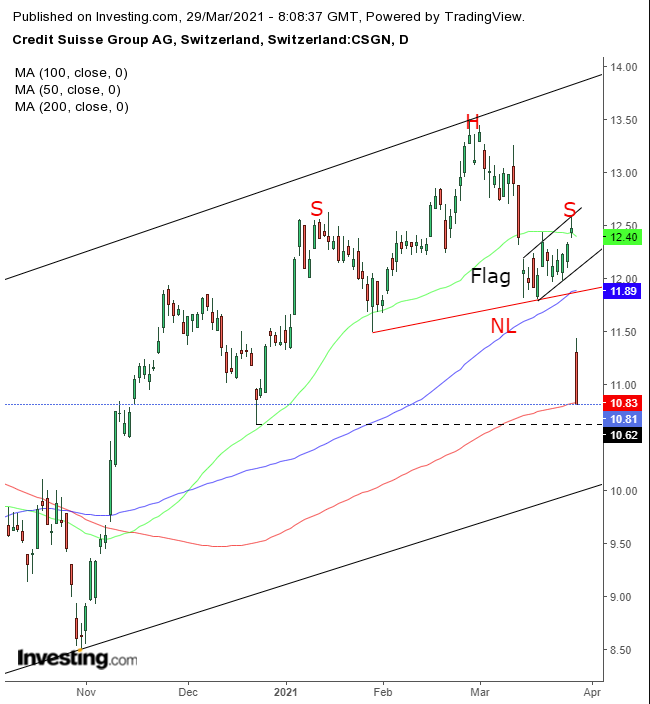
The stock used the market mechanism of a rising flag to garner sufficient force to complete a H&S top. Note, the 50 DMA provided resistance to the flag or right shoulder of the top, the 100 DMA confirmed the neckline and the 200 realigned with the Dec. 21 low and the 200 DMA, above the next test, the uptrend line/Rising Channel bottom since the March bottom. Note too, the H&S & flag can achieve its results while maintaining its uptrend.
Pre-US Market Review
On Friday, American equities advanced to new records on positive vaccine news and the decision by the Federal Reserve to ease dividend and buyback restrictions on US banks at the end of June. The easing, which compensates for earlier tightening, reflects the positive economic outlook as well as the view that US banks have successfully weathered the economic storm of the coronavirus pandemic. The Fed also removed the pandemic-era “supplementary leverage ratio,” which reduced banks’ requirements for cash reserves.
The S&P 500 Index jumped the most in three weeks, late in Friday's session, closing at its highest level ever. Investors turned to risk after President Joseph Biden doubled his 100-day nationwide vaccine goal to 200 million.
While in Europe last week, the reflation trade favored miners and energy firms, the cyclical rotation wasn’t so clear in the US. Technology stocks (+2.54) outperformed but Communication Services (-1.1%)—the other half of big tech that benefited during lockdowns—was the only sector in the red.
However, Communication Services did not fall due to the reflation trade. Rather, the sector slumped following negative comments from Ohio Republican, Bill Jonson. Facebook (NASDAQ:FB), Alphabet (NASDAQ:GOOGL) and Twitter (NYSE:TWTR) all traded lower after Johnson said, "big tech is essentially handing our children a lit cigarette and hoping they stay addicted for life."
Oil jumped 4.2%, almost erasing a 6.8% loss, closing just 0.7% lower for the week. Normally, this, too, would be a sign that sectors depressed during social restrictions are rising on the expectation of the reopening economy. However, WTI was higher simply because a tanker was blocking the Suez Canal and disrupting oil distribution.
Maybe we can be encouraged by financials’ gaining 1.6%? Afraid not. It was simply a response to the Fed lifting its dividend restrictions. Still, Real Estate climbed 2.44%, not far behind technology. Truth be told, most sectors rose robustly so we can’t really consider Friday's activity to be representative of the Reflation Trade.
In pre-US market open trading on Monday, yields on the 10-year Treasury note—which were the catalyst for the shakeup in stocks—were little changed.
The dollar was retesting last week’s highs.
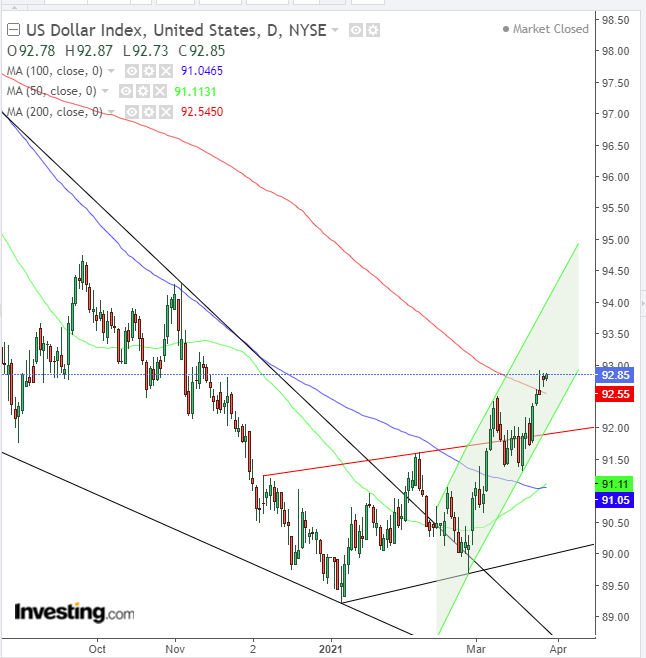
The greenback remained over the 200 DMA for the second day, for the first time since May. However, the price found resistance by Thursday’s very bearish shooting star. This nonetheless extended a new uptrend for the USD, which had completed a double bottom, created with the completion of a falling wedge since March.
Gold was flat for the fifth day, reducing the chances of a rising flag.
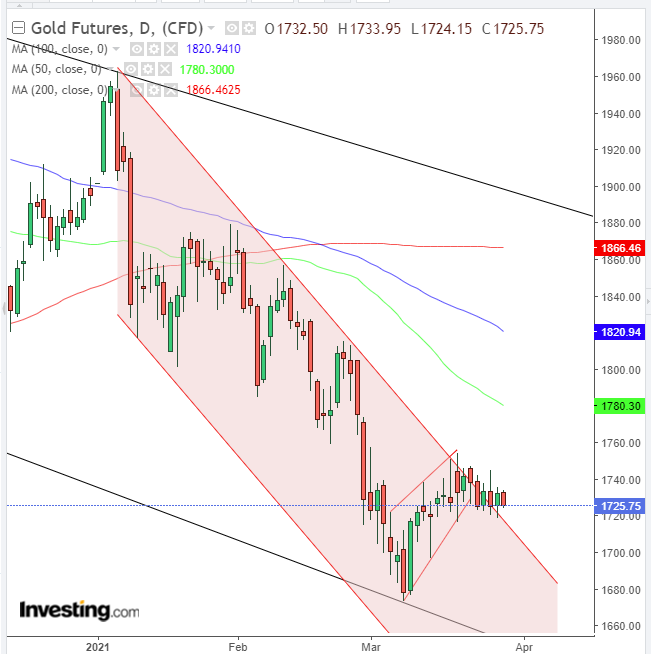
If the price manages to climb above the falling channel, certainly above the flag, it will increase the chances of retesting the channel top. Warning: this is still a falling channel, which means that the impetus is to the downside.
Bitcoin moved higher as cryptocurrencies are gaining more acceptance in financial markets. However, it found resistance at the top of a falling channel, bullish after the 41.7% surge in just two weeks.
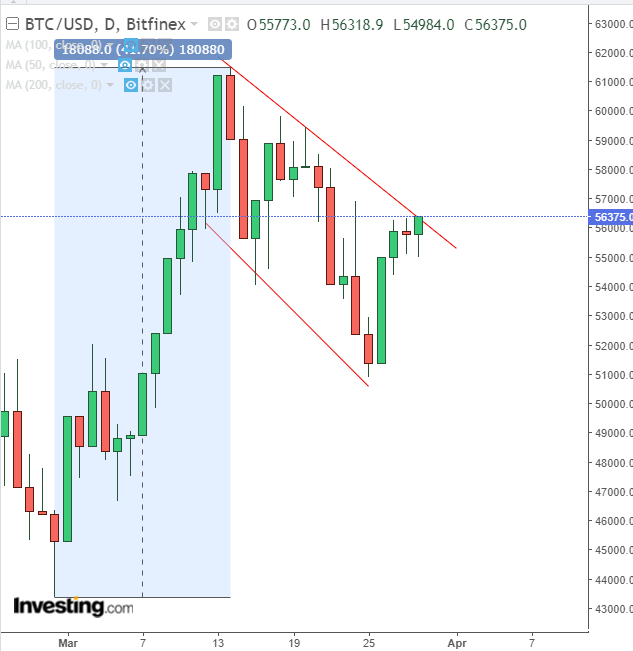
The pattern is complete with an upside breakout.
This morning, oil pared last week's gains after the tanker that had been blocking the Suez Canal last week was reflated. Investors were also concerned about the effects of lingering lockdowns on demand ahead of Thursday's OPEC+ policy meeting.
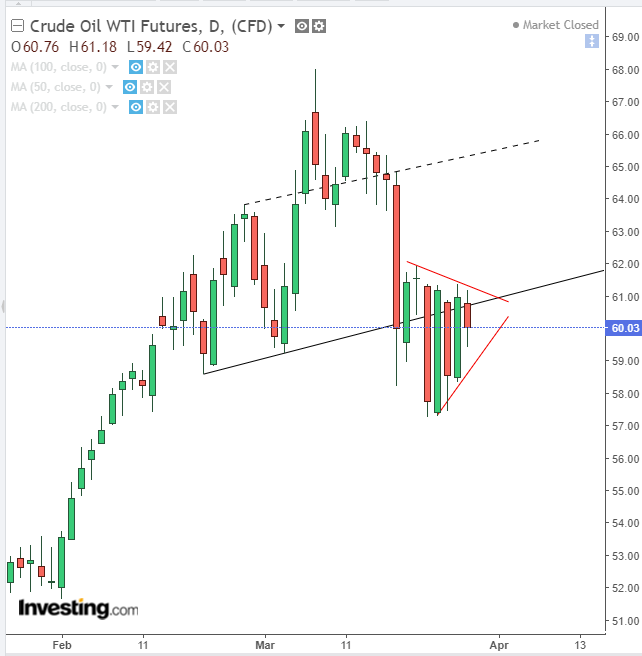
Oil has been trading within a pennant, bearish after the 10.2% plunge in a single day that led to the give-and-take between buyers and sellers. A downside breakout would signal a resumption of the downturn. Even if the price would return to $66 (depicted by the dotted line), it could still be part of the dynamics of a H&S top.
Up Ahead
Market Moves
Stocks
Currencies
Bonds
Commodities
